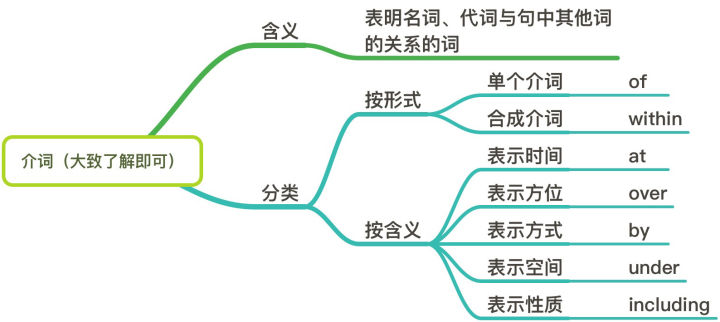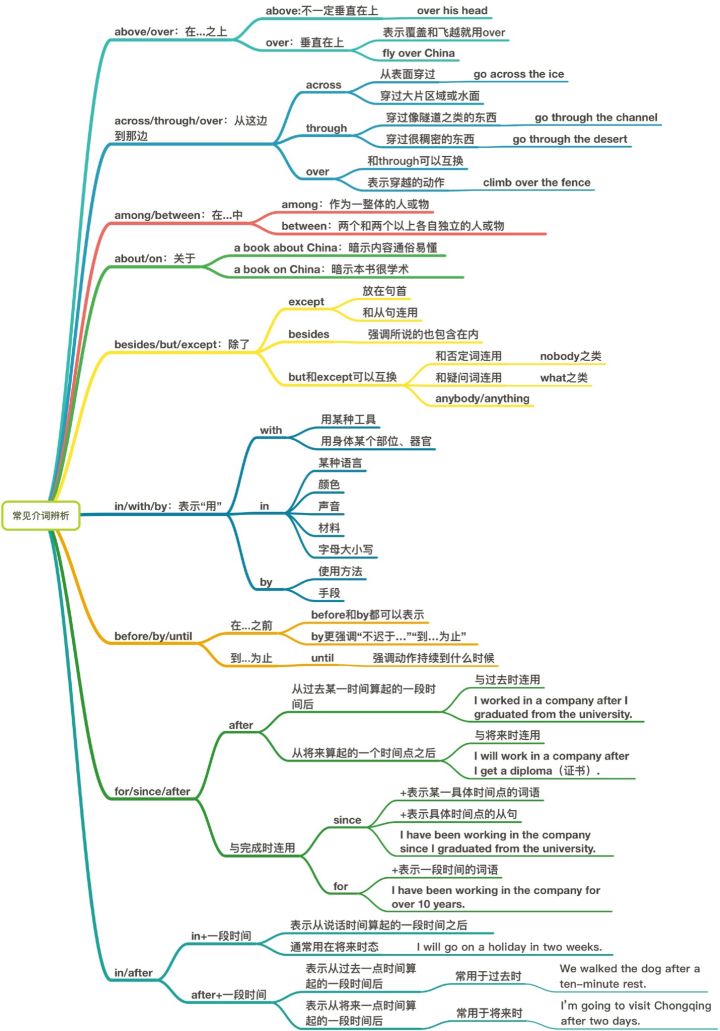英语句子的核心是:主语+谓语
主+谓构成了最简单的句子,然后再加介词,加不定式,加分词,加从句,复合句,最后构成了纷繁复杂的段落、文章。
而这些在“主+谓”的结构上添加的东西,不外乎是六个W。
Who (什么人)
When (什么时间)
Where (在什么地点)
What (做了什么)
Why (为什么?原因。)
How (怎么做的?)
当然,还可以加上条件、结果,这样就构成了八个常见的状语从句。
附:新闻的要素,五个W和一个H是指什么?
新闻六要素(也就是记叙要素):时间、地点、人物、事件的起因、经过、结果。即五个“W”和一个“H” 即Who(何人) 、What(何事) 、When(何时)、Where(何地) 、Why(何因)、How(如何)。
一、介词
首先来学习一下介词,英语中介词后面必须跟名词、代替名词的代词、和名次共一样的动名词(-ing),以及名词短语、名词性从句---宾语从句。介词的主要用途有表时间、表方位、表进行、表原因(for 表原因,不能放句首),参考:http://baijiahao.baidu.com/s?id=1601706525352302451&wfr=spider&for=pc
首先,汉语喜欢用动词。介词常常起到中文中动词的功能。
另外一个例子可以用来解释为什么介词难学的原因
举个例子,要表达“这位钢琴家凭记忆演奏了整首乐曲”,你写出来的可能是:
(*) The pianist played the whole piece by memory.
但正确的说法应该是:
The pianist played the whole piece from memory.
连词
其中的Fanboy在这篇文章中也出现过,coordination conjunction是并列连词,subordination conjunction不就是从属连词嘛。
另外,关于an,a的用法:
(1) 拼写以辅音字母开头读音却以元音开头的单词
hour, honest, honor等单词的拼写虽然以辅音字母h开头,但其读音却以元音开头,因此,前面要用an。
(2) 拼写以元音字母开头读音却以辅音开头的单词
useful, university, usual, united, European, one-eyed, one-way等单词的拼写虽然以元音字母开头,但其读音却以元音开头,因此,前面要用a。
(3)在26个英文字母中,a, e, i, o, f, h, l, m, n, r, s, x这12个字母的读音是以元音开头的,其余字母的读音则是以辅音开头的
第三个有捷径可以记,“Mr.Li has one fox.”这句话里的所有字母,单独使用的时候前面要用an。




二、不定式作状语
1.表目的 She writes a lot to become a writer.
2. 表结果 What have I said to make you so angry?
3. 表原因 She was surprised to see him.
其他:
1.接ing.
This is an Email group for Canadians who are committed to adopting from China, in the process of doing so, or who have already adopted.
因为:be committed to 献身于,致力于; (后接名词或动名词,to是介词)
再看知乎的讨论:
education is the key to bridge the wealth gap.
我的老师告诉我,这个to是介词,所以应该不是不定式,应该是to bridging the wealth gap.
利用语境来联想对比一下。to作不定式的时候通常表示目的、要做的事情,多半修饰前面的动作。举栗子:I want to meet you tomorrow,to meet you是进一步说明want且表要做的事情;I eat apples to stay healthy,同样这里to不定式是为了进一步修饰吃苹果这件事。
而to作介词一般不表示目的或要做的事,介词本身后面也就是接名词的,所以这样的情况下to后面就加名词。举栗子:I have access to this database,此处to并不是为了进一步修饰动作,不表示目的;还有土澳公交车上常见的一句话 This bus is limited to standing 15 people,这里的to也并不修饰任何动作,没有进一步表示目的。
三、分词作状语
1. 时间状语 Hearing the news,they all jumped with joy.(=When they heard the news,they...)
2. 原因状语 Not knowing her address,I can't write to her
3. 方式状语 ..But later,people developed a way of printing,using rocks.
4. 条件状语 Taking(=If you take)the path that leads out of the town,you will come to a dense wood. .
5.结果状语 I thought he was making fun of me,and ran faster than ever,reaching(=so that I reached)the school yard quite out of breath.
6. 目送状语 At one time I used to go skiing every winter.
现在分词用作目的状语的用法非常有限,主要见于那些表示人们所从事的活动方面的动词,如boating, climbing, fishing, hunting, riding, sailing, shopping, shooting, skating, skiing, swimming, walking, washing等。
还有其他的一些比如作伴随状语、起补充说明作用等。
四.定语
1.不定式作定语
She has lots of stories to write.(时间性继承谓语动词的时间(现在),表达了定语的动态性)
2.介词作定语
The bird in the tree.
3.过去分词作定语
We will visit a boy named Charlie Green.
a new TV program called Monkey(过去分词短语作后置定语,相当于一个定语从句,即a new TV program that is called Money)
4.定语从句
五、状语
1.不定式作状语
2.介词作状语
We live quite near my office.(地点)
Who knows what will happen in the future?(时间)
The sewing machine is worked by foot.(方式)
https://www.zybang.com/question/73d8772f19e801fd4a379905c4501311.html
还有自己收集的:
The little boy began to blush after seeing a beautiful girl.
3.分词作状语
Every day they went to the road nearby and stood there begging.
4.状语从句

